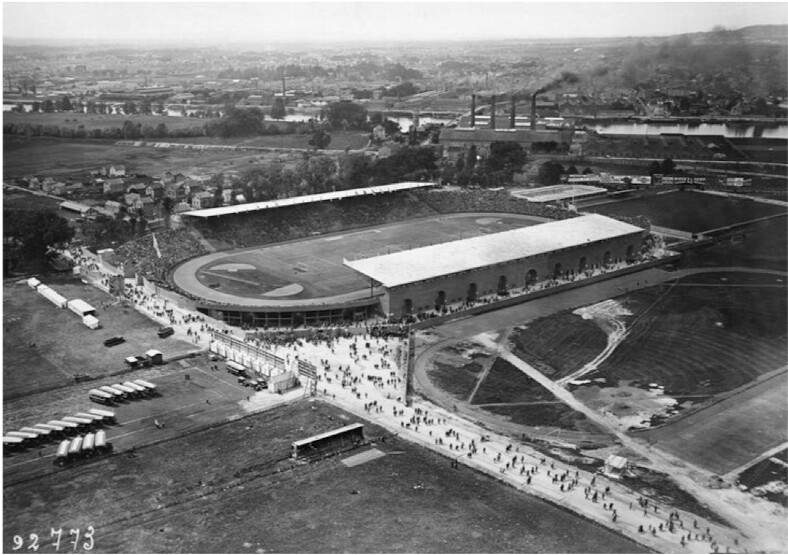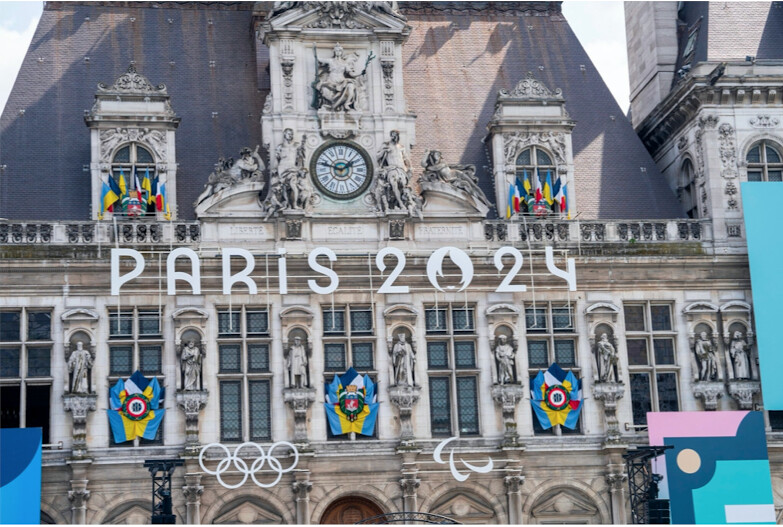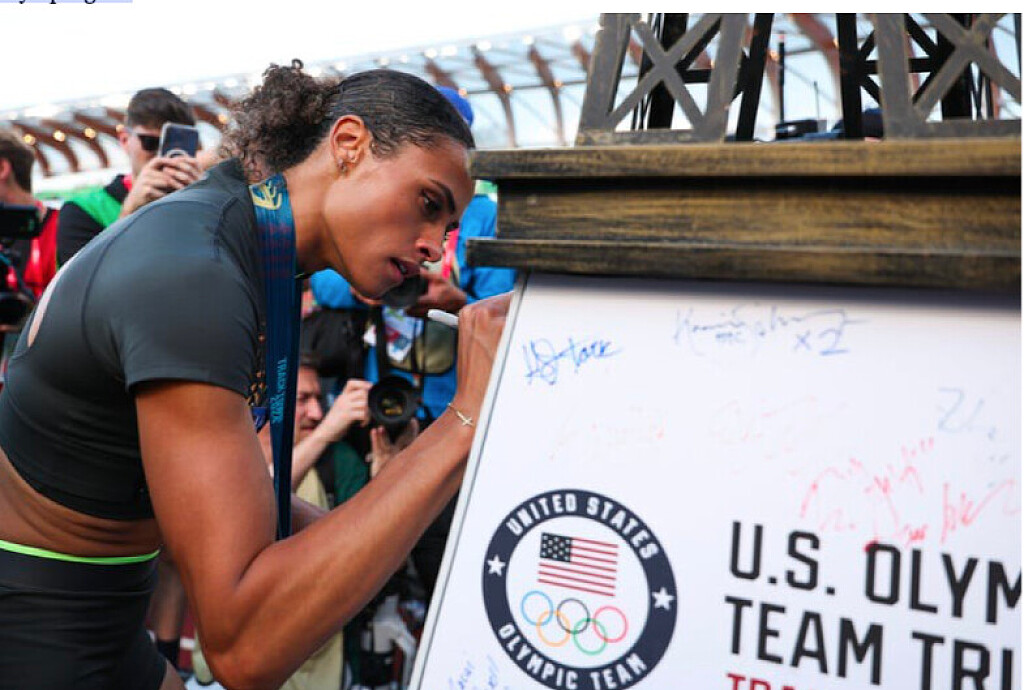Running News Daily
Running News Daily is edited by Bob Anderson. Send your news items to bob@mybestruns.com Advertising opportunities available. Train the Kenyan Way at KATA Kenya and Portugal owned and operated by Bob Anderson. Be sure to catch our movie A Long Run the movie KATA Running Camps and KATA Potato Farms - 31 now open in Kenya! https://kata.ke/
Index to Daily Posts · Sign Up For Updates · Run The World Feed
8 Things You Need to Know About the Paris Olympics—Plus How to Watch
The biggest sport at the Paris Olympic Games will be held on August 1-11. And while it’s the oldest Olympic discipline, a lot will be new about track and field this year.
A lot has changed in the last 100 years. Feathers, jazz, and radios are out. Mom jeans, T-Swift, and TikTok are in.


(We don’t make up the rules.)
Dirt tracks have been replaced by vibrant shades of bouncy mondo. Leather shoes cower next to featherlight carbon-plated spikes. Scouts sprinting along marathons, calling in the action by telephone to announcers projecting the information to spectators sitting in the stands, have been put out of business by helicopters and motorcades livestreaming the race on TV.
But one thing hasn’t changed: the 2024 Olympic Games will be held in Paris, France—where they were held for the last time exactly 100 years ago. And once again, track and field will be the star of the show.
(Sorry, break dancing and skateboarding.)
Here’s what you need to know about track and field, or what the rest of the world calls “athletics,” at the 2024 Paris Olympic Games on August 1-11.
Of the 10,000 athletes from 206 nations competing in 329 events at the Paris Olympic Games, 1,800 of them will be in the 48 events of track and field. That makes track and field by the numbers the biggest of the 32 sports.
It’s a fitting designation for a historic sport that traces its roots back to about 200 B.C. in Ancient Greece and the birth of the Olympics. Then, men (yes, just men) competed in sprints, the long jump, discus, and javelin to celebrate human potential and to honor the gods.
Those events are all still contended today (plus a whole lot more that would make the Ancient Greeks—and many of our contemporaries, for that matter—scratch their heads, like the 3,000-meter steeplechase and the 20K racewalk), giving special import to this sporting discipline.
In addition: unlike say, soccer or basketball, which have the Football World Cup and the NBA Finals, the Olympics represents the pinnacle of the sport for track and field. For all the disciplines within track and field, from the 100 meters, to hammer throw, to the decathlon, there is no higher honor than winning Olympic gold.
It’s been a long, arduous road since Pierre de Coubertin, founder of the modern Olympic Games in 1896, famously said that the point of the Olympics was “the solemn and periodic exaltation of male athleticism…with the applause of women as reward.”
At the 1900 Olympics, also in Paris, 22 women defied Coubertin’s dream and competed in a total of five events: croquet, equestrian, golf, sailing, and tennis. They made up a minuscule 2.2 percent of the 997-person field. This year, thanks to tireless work starting with the International Olympic Committee, the Paris Olympics will be the first to (basically) achieve gender parity.
Of the 329 medal events, 157 will be contested among men, five more than the 152 for women. (There are also 20 mixed-gender events, including the mixed-gender 4×400-meter relay on the track and the mixed-gender marathon race walk relay.) But within the 32 sports, 28 are gender equal—including, for the first time, track and field.
The devil is in the details, and if we’re putting true parity paramount then there’s still some work to go. Even within track and field, the men still compete in the decathlon (10 events) while the women compete in the heptathlon (seven). And then there’s everyone on the team beyond the athletes themselves: in Tokyo three years ago, 13 percent of coaches were women—and that’s up from 11 percent in Rio in 2016. A quarter of National Olympic Committees give less prize money to women gold medalists than men.
Speaking of prize money, track and field is breaking barriers this Olympics by becoming the first sport to give out prize money. Gold medalists in both women’s and men’s races will win $50,000, with relay teams splitting that pot four ways. In total, that’s $2.4 million that World Athletics will be coughing up to foot the bill, a sign of change for how the Olympics have bloomed from an exhibit of amateurism to full-blown commercialization.
Notably, this prize money is less than World Athletics hands out at the World Athletics Championships, which awarded gold medalists $70,000 in Budapest last summer. World Athletics intends to extend prize money to silver and bronze medalists at the 2028 Olympic Games in Los Angeles.
That prize money from World Athletics remains separate from prize money awarded by some national federations—including the U.S. Olympic and Paralympic Committee, which will award $37,500, $22,500, and $15,000 to Team USA gold, silver, and bronze medalists, respectively, in Paris.
Paris vowed to make this Olympics the greenest ever, building as little new infrastructure as possible and using the city’s iconic landmarks as venue backdrops instead. Rather than build dazzling new stadiums which quickly fall into disuse and disrepair after the Games—as we’ve seen at previous Olympics—Paris opted to revamp existing infrastructure, some of it dating back to the last Olympic Games here in 1924.
The Stade de Yves-du-Manoir, the main stadium of the 1924 games which hosted among other things track and field, has a new 1,000-seat grandstand and will host the field hockey events.
The pastel-colored high-rise apartments of the Olympic Village, where many athletes stay during the Games, add a splash of color to Seine-Saint-Denis, the poorest area not only in Paris, but the country. Water pumped from deep below the earth cool the apartments made from a mix of wood and concrete (although many delegations have requested AC units nonetheless) and the avenues outside are made from a permeable pavement composed of crushed seashells that cool the streets by allowing water stored underneath the ground to evaporate on hot days.
This initiative has also fast-tracked cleaning up the famously romantic and infamously gray city. Paris has built 250 new miles of bike lanes, continued to expand its Metro network, allegedly cleaned up the Seine, and planted 300,000 new trees.
Track and field will be held on France’s biggest stage, quite literally. Built for the 1998 Football World Cup, Stade de France seats more than 80,000, making it the largest stadium in France. It’s home to the French national football (soccer) and rugby teams as well as the country’s biggest concerts.
As you’ve probably seen by now, the track has been resurfaced to purple for the Games. The shade is reminiscent of lavender, a homage to both the creativity of the 2024 Olympics and to the ash-colored track at the 1924 Olympic Games across the city.
If you’ve watched track and field meets in the past, you may have been confused why some athletes names’ appear with a big “Q” or a little “q” on the scoreboard after the preliminary and semi-final rounds.
If that’s you, don’t stress. In the spirit of second chances, and well, simplicity, the Paris Games are doing away with this system (for the most part).
For the first time ever, individual track events ranging from the 200 meters to the 1500 meters (including hurdles races) will include a “repechage” round. Athletes in the preliminary round who do not automatically qualify for the semi-final will have an opportunity to race their way into the next round through this additional heat, the entomology of which comes from repêchage, or “second chance” in French.
Under this new format, events will have four rounds: preliminary, repechage, semi-final, and final. This guarantees that every athlete competing in the 100 through the 1500 will have the opportunity to race twice. The number of athletes who will advance out of the repechage to the semi-final varies depending on the event.
The repechage round replaces the former system, in which athletes advanced by running the fastest in their heats (Q), plus the next best getting in on time (q).
The 100 meters already has an additional round of preliminary heats, and the distance events (3,000-meter steeplechase, 5,000, and 10,000) require adequate time to recover, so these events will be conducted without the repechage round.
Expanding on the theme of gender equality at the Paris Olympics, the marathon route pays homage to a pivotal moment in women’s history during the French Revolution: the Women’s March on Versailles. The roughly 160 competitors in the men’s and women’s races (as well as the citizen’s race, Paris 2024 Marathon Pour Tous) will follow in the footsteps of roughly 7,000 Parisian women and men who marched from Paris to Versailles on October 5-6, 1789 to demand bread and arms. (It worked: King Louis XVI finally agreed to sign the Universal Declaration of the Rights of Man and Citizens that day.)
Just like those disgruntled Parisians 235 years ago, runners will start at Hôtel de Ville, the city hall in the center of Paris, and will make their way on foot to the Palace of Versailles about 12 miles to the west. Along the way, runners will pass through nine districts of the Île-de-France, against a backdrop of the City of Light’s most iconic landmarks, parks, and forests, including the Place de Concorde, Rue de Rivoli, Tuileries Garden, and, of course, the Louvre.
In addition to being steeped in history and splendor, the course will be particularly grueling for a road race: the middle section packs some kickers that add up to over 1,430 feet of climbing and descent, with a maximum grade of 13.5 percent. Throw in some heat and humidity and we’re in for two unpredictable, action-packed events.
You may be wondering why race walking, in which competitors basically try and cheat as much as possible without getting caught, is an Olympic discipline. We are, too. Just watching race walkers swing those hips along at 6-minute per mile paces seems injury-inducing. But hey, three-on-three basketball, badminton, and trampoline are in the Olympics, too, so who are we to judge.
But judging is in fact a critical component of sport. Race walking rules stipulate that competitors must keep one foot on the ground at all times, to the point where any loss of contact is not visible with the naked eye. In other words, the rules are basically begging athletes to cheat and run without getting away with it. In addition, the lead leg must remain straight until that leg passes under the body. Using just the naked eye, that is, no technology whatsoever, judges monitor competitors to try and uphold these regulations.
For the first time since the discipline became an Olympic event in 2000, race walking will provide gender-equal medal opportunities. There will be a men’s and women’s 20K race, as well as a marathon-distance mixed-gender relay, which will replace the men’s 50K.
In a highly unique format, the mixed-gender relay will see 25 teams of one man and one woman each. They’ll complete a marathon-distance race broken up into four 10K chunks, with each competitor racing twice (man, woman, man, woman).
Perhaps the greatest improvement from the 1924 Olympic Games is that we can watch it all without even being there. NBC Universal, the American multinational mass media and entertainment conglomerate that owns the media rights to the Olympics, is planning to air more than 7,000 hours of total coverage of the Paris Olympic Games. Track and field coverage will be broadcast on the NBC, USA, and E! TV networks and streamed on Peacock, NBCOlympics.com, NBC.com, NBC app, NBC Olympics app, and NBC Sports app.
The action kicks off with the men’s and women’s 20K race walk on August 1, and concludes with the women’s marathon on August 11. In between, enjoy a nine-day action-packed feast on the track at Stade de France. Find the full track and field schedule of events here and the full track and field viewing schedule here.
Morning viewing sessions on August 2-9 will commence at 4 A.M. ET, and medal events will be shown on NBC’s tape-delayed prime time broadcast. Don’t worry, you can watch them live, too! Peacock, the streaming service of the Olympics, will stream every sport and event.
Those willing to sacrifice some sleep can catch the men’s marathon coverage live beginning at 2 A.M. on August 10 on USA Network, Peacock, and the NBC Sports app, while the women’s marathon will be shown live beginning at 2 A.M. on August 11.
by Outside Online
Login to leave a comment




